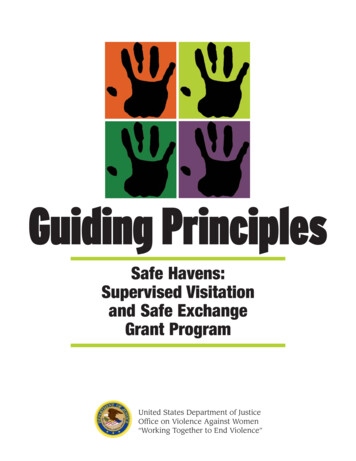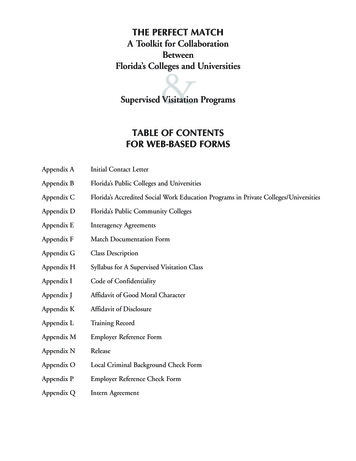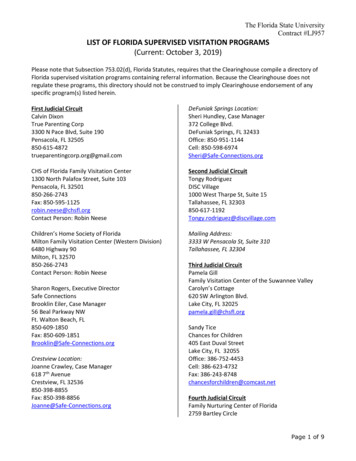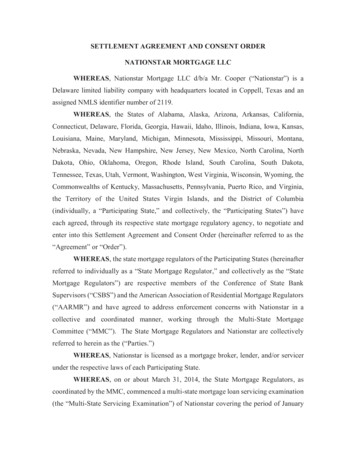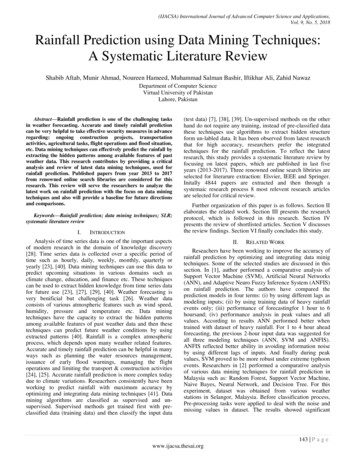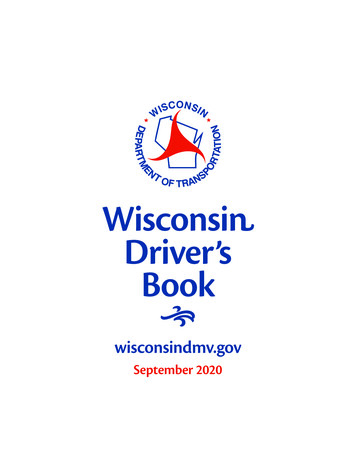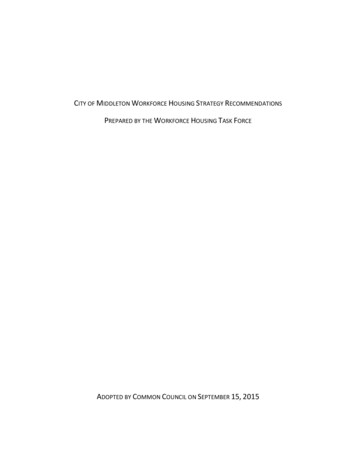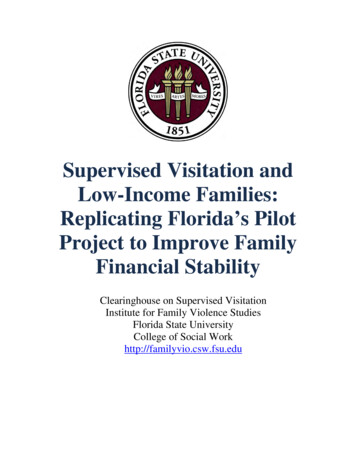
Transcription
Supervised Visitation andLow-Income Families:Replicating Florida’s PilotProject to Improve FamilyFinancial StabilityClearinghouse on Supervised VisitationInstitute for Family Violence StudiesFlorida State UniversityCollege of Social Workhttp://familyvio.csw.fsu.edu
Table of ContentsTABLE OF CONTENTS . 2INTRODUCTION . 5ABOUT THE INSTITUTE FOR FAMILY VIOLENCE STUDIES AND THE CLEARINGHOUSEON SUPERVISED VISITATION . 6ABOUT THE ADMINISTRATION FOR CHILDREN AND FAMILIES . 7ABOUT THE SPECIAL IMPROVEMENT PROJECT (SIP) PILOT . 8ABOUT FLORIDA’S SUPERVISED VISITATION PROGRAMS. 9ABOUT THE DEPARTMENT OF REVENUE AND CHILD SUPPORT ENFORCEMENT INFLORIDA . 10ADDING CHILD SUPPORT ENFORCEMENT AS A COMMUNITY PARTNER IN FLORIDA’SBEST PRACTICES . 11THE IMPORTANCE OF CONNECTING FAMILIES TO ECONOMIC AGENCIES ANDSERVICES . 12THE EFFECTS OF THE RECESSION ON CHILD WELFARE . 12PARENTAL PROTECTIVE FACTORS. 14EXAMINING FINANCIAL STABILITY IN FLORIDA’S FAMILIES. 21Current Financial US and Florida Census Data . 22NEW WAYS OF THINKING ABOUT OUTREACH: THE 5 W’S OF OUTREACH BETWEENSUPERVISED VISITATION PROGRAMS AND ECONOMIC SERVICES . 28WHY SHOULD LINKAGES EXIST? . 28WHERE ARE ECONOMICALLY‐RELATED PROGRAMS LOCATED? . 28WHO SHOULD LINK SUPERVISED VISITATION TO ECONOMIC SERVICES? . 29WHEN SHOULD SUPERVISED VISITATION PROGRAMS REACH OUT TO LOW‐INCOME FAMILIES? . 30WHAT SHOULD THOSE LINKAGES LOOK LIKE, AND HOW CAN THEY BE MADE?. 30STEPS FOR HELPING FAMILIES . 32STEP 1: IDENTIFY TYPES OF ORGANIZATIONS / ENTITIES CRUCIAL FOR FAMILIES’ ECONOMICADVANCEMENT . 32STEP 2: ESTABLISH PARTNERSHIPS WITH OTHER ORGANIZATIONS / ENTITIES CRUCIAL FOR FAMILIES’ECONOMIC ADVANCEMENT . 32STEP 3: IDENTIFY CLIENTS WHO CAN BENEFIT FROM THE SERVICES OFFERED THROUGH PARTNERINGORGANIZATIONS/ENTITIES. 33STEP 4: LINK CLIENTS TO THE PARTNERING ORGANIZATIONS/ENTITIES . 34STEP 5: REPEAT STEPS 1 AND 2 IF NECESSARY . 34STEP 6: FOLLOW‐UP WITH CLIENTS WHO HAVE BEEN LINKED TO PARTNER ORGANIZATIONS/ENTITIES . 34TYPES OF ORGANIZATIONS / ENTITIES CRUCIAL FOR FAMILIES’ ECONOMICADVANCEMENT. 36CHILD SUPPORT ENFORCEMENT SERVICES OF FLORIDA . 362
JOB PLACEMENT OFFICES . 36COMMUNITY ACTION AGENCIES . 36AGRICULTURAL EXTENSION OFFICES . 36FATHERHOOD PROGRAMS . 36BIG BROTHERS/BIG SISTER MENTORSHIP PROGRAMS . 37LEGAL AID/LEGAL SERVICES . 37ASSETS FOR INDEPENDENCE . 37DOMESTIC VIOLENCE CENTERS . 37HEAD START . 37EARLY INTERVENTION SERVICES . 38LOCAL HEALTH DEPARTMENT OFFICES . 38ADULT DISABILITY SERVICES . 38VOCATIONAL REHABILITATION SERVICES . 38LITERACY PROGRAMS . 38SUBSTANCE ABUSE COUNSELING CENTERS . 38MENTAL HEALTH SERVICES PROVIDERS . 38TROUBLESHOOTING: LESSONS LEARNED FROM THE SIP PILOT PROJECT . 39AN EXERCISE FOR SUPERVISED VISITATION PROGRAM DIRECTORS AND LEAD STAFF: THINKING ABOUTFINANCIAL LITERACY AND ECONOMIC STABILITY . 43TIPS FOR DEALING WITH PROGRAM STAFF TURNOVER . 44Overview . 44Why Turnover Happens . 44Preventing Turnover . 46After Turnover. 47CASE SCENARIO: DISINTERESTED ANN . 48CASE SCENARIO: MS. GREENFIELD & THE SUNSHINE STATE VISITATION PROGRAM . 49CASE SCENARIO: JESSE & THE FAMILY FUN VISITATION CENTER . 50PROGRAM REPORTS . 52CASE SERVICES REPORTS – CHILDREN’S JUSTICE CENTER SUPERVISED VISITATION PROGRAM SERVICESREPORT STATISTICS . 52CASE SERVICES REPORTS – JUDGE BEN GORDON, JR. FAMILY VISITATION CENTERSERVICES REPORT STATISTICS . 59CHILD SUPPORT ENFORCEMENT FINDINGS. 62JUDGE BEN GORDON JR. FAMILY VISITATION CENTER . 62CHILDREN’S JUSTICE CENTER, SUPERVISED VISITATION PROGRAM . 62CLIENT FEEDBACK . 64THE IMPORTANCE OF CLIENT FEEDBACK . 64CLIENT RESPONSES TO SATISFACTION REPORTS . 64APPENDICES . 68APPENDIX A: LINKS TO NATIONAL FINANCIAL LITERACY RESOURCES . 683
APPENDIX B: FORMS . 92B‐1: LETTERS OF AGREEMENT/MEMORANDA OF UNDERSTANDING . 92B‐2: SAMPLE INTAKE FORMS . 94B‐3: SAMPLE CLIENT SATISFACTION FORMS . 100APPENDIX C: RESOURCES FOR CLIENTS . 101C‐1: INFORMATIONAL POSTERS FOR DISPLAY . 101C‐2: AFFIRMATION CARDS FOR PARENTS . 103C‐3: FLYERS/INFORMATIONAL BROCHURES . 108APPENDIX D: PROGRAMS AND SERVICES PROVIDERS IN FLORIDA BY COUNTY . 111D‐1: CHILD SUPPORT ENFORCEMENT LOCATIONS . 111D‐2: SUPERVISED VISITATION PROGRAMS . 114D‐3: JOB PLACEMENT OFFICES. 119D‐4: COMMUNITY ACTION AGENCIES . 125D‐5: AGRICULTURAL EXTENSION OFFICES . 138D‐6: FATHERHOOD PROGRAMS . 142D‐7: BIG BROTHER/BIG SISTER MENTORSHIP PROGRAMS . 151D‐8: LEGAL AID/LEGAL SERVICES . 155D‐9: ASSETS FOR INDEPENDENCE . 161D‐10: DOMESTIC VIOLENCE CENTERS . 162ALACHUA COUNTY . 162D‐11: EARLY HEAD START (PREGNANT WOMEN & CHILDREN BIRTH TO 3 YEARS OLD). 167D‐12: PRESCHOOL HEAD START (CHILDREN 3 TO 5 YEARS OLD) . 170D‐13: MIGRANT HEAD START (CHILDREN 6 WEEKS TO 5 YEARS OLD) . 174D‐14: HEALTHY FAMILIES FLORIDA – EARLY INTERVENTION SERVICES. 176D‐15: LOCAL HEALTH DEPARTMENT OFFICES. 179D‐16: ADULT DISABILITY SERVICES. 182D‐17: VOCATIONAL REHABILITATION SERVICES . 188D‐18: LITERACY PROGRAMS. 193D‐19: SUBSTANCE ABUSE COUNSELING CENTERS . 208D‐20: MENTAL HEALTH SERVICES PROVIDERS . 215APPENDIX E: REFERENCES . 232E‐1: THE EFFECTS OF THE RECESSION ON CHILD WELFARE . 232E‐2: PARENTAL PROTECTIVE FACTORS . 233E‐3: EXAMINING FINANCIAL STABILITY IN FLORIDA’S FAMILIES. 2344
IntroductionIn 2010, the Florida State University Clearinghouse on Supervised Visitation identified anopportunity to help supervised visitation programs broaden their reach to increaseeconomic opportunities and improve Child Support Enforcement (CSE) outcomes for clientfamilies. Supervised visitation has been used in Florida for many years to provide a safeplace for noncustodial parents to spend parenting time with their children in casesinvolving child abuse, maltreatment, domestic violence, mental illness, and substanceabuse. Although parents are referred to supervised visitation for various reasons, theseFlorida families share one overarching characteristic: they are predominantly low‐income,with most earning less than 20,000 per year (Clearinghouse, 2010).Notably, Florida has one of the most comprehensive approaches to supervised access andvisitation in the United States. Other states and funders focus on providing technicalassistance and training to only one type of supervised visitation program, such as programsthat take domestic violence cases or programs that receive special federal or state funding.By contrast, the Clearinghouse on Supervised Visitation at Florida State University isspecifically named in Florida Statutes to provide in‐depth training and technical assistanceto all of Florida’s 70 programs, without regard to funding stream or case type. Florida’swide array of supervised visitation programs are housed in faith‐based groups, are part oflarger umbrella social services organizations, or operate as non‐profit 501(C)(3) programs.All of Florida’s supervised visitation programs are part of the coordinated communityresponse to child endangerment. These programs are linked to dozens of communitypartners, including the Department of Children and Families, the Office of the State CourtsAdministrator, the Guardian ad Litem Program, the Florida Department of LawEnforcement, the Children’s Advocacy Centers, and the Domestic Violence Victim AdvocacyCommunity. Yet a crucial service gap has existed for these programs, one that theClearinghouse seeks to fill: in the past, programs have not provided low‐income familieswith the means to improve economic self‐sufficiency.In 2010, the Clearinghouse received funding under Administration for Children andFamilies grant number 90FI107. With this funding, the Clearinghouse began a pilot projectat two supervised visitation programs, the Judge Ben Gordon Family Visitation Program,and the Children’s Justice Center Supervised Visitation Program. With the FloridaDepartment of Revenue as a major partner, the pilot project demonstrated that by slightlyexpanding their referral practices, supervised visitation programs can help clients improvetheir financial stability.This guide is a result of lessons learned in the pilot project. It provides research,information, and resources for supervised visitation programs to help low‐income clientsimprove their child support outcomes and increase their economic self‐sufficiency.5
About the Institute for Family Violence Studies and theClearinghouse on Supervised VisitationThe Clearinghouse on Supervised Visitation (Clearinghouse) is housed in the Institute forFamily Violence Studies (IFVS) at Florida State University. The primary goal of the IFVS isthe elimination of all forms of domestic violence. The research conducted at the IFVS helpsto increase the knowledge base about interventions that work, provide technical assistanceand training for service providers and advocates, and serve as a resource for professionalsand the general public. The Clearinghouse provides technical assistance to all of Florida’ssupervised visitation and monitored exchange program with a grant from the FloridaDepartment of Children and Families.Karen Oehme, J.D. serves as the Director of the Institute. Zachary Summerlin, M.S.W. is theProject Manager.The Institute for Family Violence Studies and the Clearinghouse on Supervised Visitationcan be reached using the contact information below.Institute for Family Violence StudiesClearinghouse on Supervised VisitationFlorida State University, College of Social WorkC2309 University CenterTallahassee, FL 32306‐2570Phone: 850‐644‐6303Email: koehme@fsu.eduhttp://familyvio.csw.fsu.edu6
About the Administration for Children and FamiliesThe Administration for Children and Families (ACF) provides national leadership anddirection to plan, manage, and coordinate the nationwide administration of comprehensiveand supportive programs for vulnerable children and families. ACF oversees and finances abroad range of programs for children and families, including Native Americans, personswith developmental disabilities, refugees, and legalized immigrants, to help them developand grow toward a more independent, self‐reliant life. These programs, carried out bystate, county, city and tribal governments, and public and private local agencies, aredesigned to promote stability, economic security, responsibility, and self‐sufficiency.The Administration of Children and Families can be reached using the contact informationbelow.Department of Health and Human ServicesAdministration of Children and FamiliesOffice of Child Support Enforcement370 L’Enfant Promenade SWWashington DC 20447http://www.acf.hhs.gov/programs/cse7
About the Special Improvement Project (SIP) PilotThe Special Improvement Project (SIP) Pilot Program was designed to help families whouse supervised visitation programs by providing them access to Child SupportEnforcement, employment resources, fatherhood programs, and other community basedresources. The ultimate goal was to increase family stability by increasing family economicstatus.This project focused on collaborating with local job placement agencies and creating a bankof resources including local access to organization offering job searching strategies. The SIPCase Manager at each of the two pilot programs identified families that were willing toparticipate in the project. The pilot programs also helped to develop client consent, intake,referral, and satisfaction forms, and met monthly with Clearinghouse staff to discuss caseoutcomes. Both pilot programs worked to identify local resources for each participatingclient, and created meaningful linkages to those resources for each client. The child supportdata for each participating client was tracked by the Florida Department of Revenue.This Replication Plan uses the lessons learned at each of the pilot programs to help othersupervised visitation programs replicate their successes.8
About Florida’s Supervised Visitation ProgramsSupervised visitation programs provide an opportunity for noncustodial parents tomaintain contact with their children in safe and neutral settings. The purpose ofimplementing supervised visitation services is to eliminate violence toward children,reduce risk for potential harm to victims of domestic violence and the children of non‐offending adults, support appropriate interaction and healthy relationships betweenparent and child, assist individuals in meeting mandated requirements, and provideopportunities for parents to meet the physical and emotional needs of the child/children. Alist of Florida’s Programs is located in Appendix D.Florida’s programs follow a system of Standards and Best Practices that are organized intoFour Main Principles regarding safety, training, dignity and diversity, and community.These can be found ess/?page id 11The rationale for using supervised visitation programs to link clients to financial resourceswas to expand current practices. Since 2007, Principle Four of the Best Practices forSupervised Visitation Programs (“Community”) states that “All programs shall operatewithin a coordinated community network of groups and agencies that seek to addresscommon family problems.” Principle Four lists numerous agencies to which supervisedvisitation programs must offer outreach and cross training. These agencies includesubstance abuse treatment providers, domestic violence centers, mental health treatment,child advocacy centers, and others, all of whom focus on non‐economic issues. Yet acommon risk factor for many of the problems that bring clients to those services is poverty.It is not poverty that causes abuse, emotional problems, or addiction, but it is often povertythat helps to keep clients from accessing help for those problems. Thus, the Clearinghouseproposed to test an expansion of Principle Four to include agencies that address clients’economic problems.9
About the Department of Revenue and Child SupportEnforcement in FloridaThe Florida Department of Revenue (DOR) has administered the Child SupportEnforcement Program since 1994. DOR staff provide child support services in all but twoFlorida Counties. The State Attorney’s Office provides services in Miami‐Dade County, andthe Manatee County Clerk of Court provides services in Manatee County.The mission of the Child Support Enforcement Program is to: make it easy for parents to provide support for their children, serve customers with respect, concern, and professionalism, ensure families can depend on their child support payments, and work with parents, partners, and the community to continually improve the childsupport program.The Florida Office of Child Support Enforcement can be reached using the contactinformation below.Florida Department of RevenueChild Support ServicesPhone: support10
Adding Child Support Enforcement as a CommunityPartner in Florida’s Best PracticesThe Clearinghouse on Supervised Visitation facilitates an assembled group of child welfareexperts called the Statewide Supervised Visitation Standards Committee, which shapes theBest Practices for Florida’s supervised visitation programs. In November 2011, theCommittee recommended that the Office of Child Support Enforcement be added to the listof community partners in the best practices. The approved new language is for Principle 4:Community.10. The Local Child Support Enforcement Office: Supervised Visitation andmonitored exchange program staff should understand the services andfunctions of the local Child Support Enforcement (CSE) office. The CSE officescan help parents establish paternity, establish child support payments,enforce support orders, locate parents, and modify orders. Such servicesincrease family economic stability and alleviate poverty. It is valuable forsupervised visitation programs to be able to provide meaningful linkages tofamilies for assistance with financial improvement and sustainabilitystrategies.Supervised visitation programs use these standards to shape service delivery.11
The Importance of Connecting Families to EconomicAgencies and ServicesResearch demonstrates that families with resources tend to weather crises better thanfamilies with fewer resources. Yet families are struggling in nearly every community.Consider the following: More than 850,000 children in Florida lived in poverty in 2009, and 626,000 havebeen impacted by foreclosures since 2007. This makes Florida the state with thesecond highest percent of children impacted by their family’s loss of a home,income, and stability. In 2010, an estimated 468,000 children in Florida lived in households in which atleast one parent was unemployed.The Effects of the Recession on Child WelfareBelow are research summaries on the effects of economic recession on child maltreatmentand family dysfunction. Sudden change in economic well‐being affects families. Recessions result in job lossand the several possible consequences thereof: housing instability, food instability,and emotional strain. These families may then be hindered in their ability to providefor their children both physically and psychologically (Huizar, 2010). The greater impact of job loss during the recession fell on industries dominated bymen (three‐quarters of all jobs lost), but it should be noted that single mothersexperienced a 68 percent increase in unemployment during the recession. In 2008, nearly 20 percent of children under 18 were living in poor households(Isaacs, 2009). At the end of 2009, 18.5 percent of households responding to theGallup Household Wellbeing Poll claimed to have had trouble buying enough foodduring the year. In 2007, over 40 percent of families with children struggled to pay for housing. Thenext year, the families of 12.7 million children were spending over 50 percent oftheir income toward housing. The US Department of Housing and UrbanDevelopment considers housing that costs more than 30% unaffordable. Low‐income families are frequently cited to bear an increased risk of contact withthe child welfare system (Adrian and Coontz, 2010; Cancian, Slack, and Yang, 2010;Sell et al., 2010). Job loss has been shown to cause a 44 percent increase in mortality of men (whohave been hit hardest in this recession) within four years and 15 to 20 percent over12
20 years. High unemployment and the resulting fears of loss of pay or jobs alsoincrease the rates of depression, sleep disturbance, and stress among those who areable to retain employment (Adrian and Coontz, 2010). Increased duration ofunemployment is predictive of increased levels of depression, substance abuse, andsuicide (Adrian and Coontz, 2010; Goldman‐Mellor, Saxton, and Catalano, 2010;Howe, Levy, and Caplan, 2004; Mossakowski, 2008; Mossakowski, 2009).Unemployment also increases the risk of domestic violence, and the NationalDomestic Violence Hotline noted an increase of nearly 50 percent in calls in 2009over the previous year. Finally, by the end of 2009 one in seven children was livingwith a recently unemployed parent (Adrian and Coontz, 2010). Divorce has been decreasing in recent years. Delaying dissolution of marriage mayincrease the negative effects on children during recession by prolonging theirexposure to high levels of conflict and by the impact of the conflict on parentingitself (Adrian and Coontz, 2010). This delay in divorce would be particularlydamaging in separations occurring because of domestic violence. Domestic violencerates also increased during the Great Depression, despite a similar fall in divorcerates (Adrian and Coontz, 2010). Berger (2004) found that income was associated with maltreatment risk and withfive factors reviewed: medical care, dental care, cognitive stimulation, emotionalsupport, and spanking. Berger concluded, as did Cancian et al., that higher incomeswould provide a protective effect for children in risk of maltreatment. Another studysuggested that maternal depression is causally associated with increasedpsychological aggression with children. In high‐risk populations, utility shut‐off, housing instability, food insecurity, andeconomic stress increase the risk of involvement with child services. The Cancian etal. report references studies that show income loss and a corresponding increase
The Institute for Family Violence Studies and the Clearinghouse on Supervised Visitation can be reached using the contact information below. Institute for Family Violence Studies Clearinghouse on Supervised Visitation Florida State University, College of Social Work C2309 University Center Tallahassee, FL 32306‐2570 Phone: 850‐644‐6303
